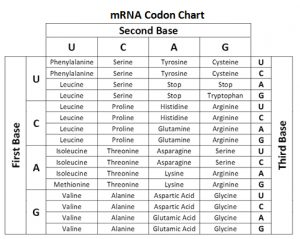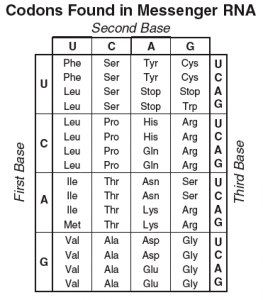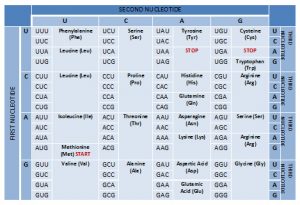mrna codon chart

Sixty one codons can be identified to determine the twenty essential amino acids needed for translation. After the initial has been identified, the remaining mRNA codons are read sequentially. A number of codons can also determine identical amino acids.
There are three types of codons. But to stop the codon, each codon encodes a particular amino acid. This is a group of three nucleotides, especially in mRNA. Our last codon is SAU, which is one of the three stop codons. A number of different codons encode the same amino acids.
DNA consists of nucleotides, and proteins are composed of amino acids. It belongs to a class of organic molecules called nucleic acids. It contains all the information for coding the amino acids that make up proteins. Be aware of the fact that RNA is different from DNA because it does not have basic nitrogen thymine. The trick to decipher DNA is known as a triplet code, in which the order of three nitrogen bases is close together from the DNA code for certain amino acids.
Various amino acids properties. It’s simple enough to determine what amino acids are made using the image below. Only one amino acid will be different, which will produce non-functional polypeptides. Will be different, but the function of the polypeptide will not be affected. Therefore, most amino acids are represented by more than one codon. The remainder of the amino acid can be encoded by more than one codon, so that the code is considered to be declining.
Introduction Codone describes a procedure for matching codons that are suitable for amino acids. This illustrates the ability of a codon to be combined with an appropriate amino acid. The introduction of an excellent codon is fundamental to the right of a polypeptide, which then results in the creation of the correct protein. This is important for proper polypeptide assembly, which in turn leads to proper protein production.
Explain why not all mutations are dangerous. Explain that students will examine several causes of mutations and learn what types of mutations might occur. Somatic mutations may come to unusual cell growth (such as cancer). A mutation can positively increase or change the function of proteins produced by genes. It’s not always bad. gene mutations are more often a consequence of two types of events. Some specific mutations in genes can have more negative effects than other mutations in the gene itself.
Rules Each RNA nucleotide coupling is made for coupling with only one other nucleotide. Three nucleotides do not overlap because they only serve in codons and never as part of other codons. There are four unique nucleotides that make up DNA molecules, each of which differs only in the form of basic nitrogen.
Both tRNA and mRNA contain information in the form of four from the baseline sequence that can be achieved in each single nucleotide. Each tRNA can only carry one amino acid at a time. So, for example, tRNA carrying Met in the inside of a polypeptide can bind only to site A.
mrna codon chart
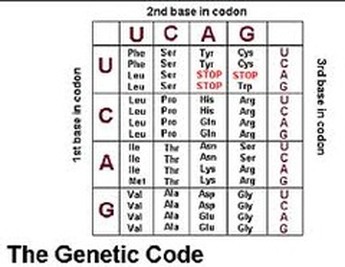
mrna codon chart Cypru.hamsaa.co
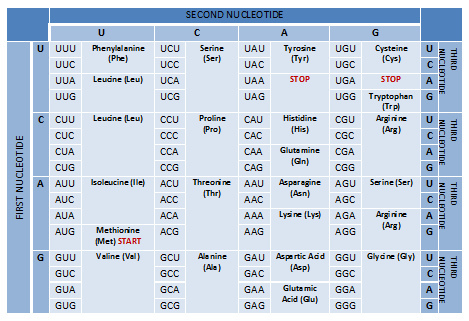
mrna codon chart

mrna codon chart Cypru.hamsaa.co
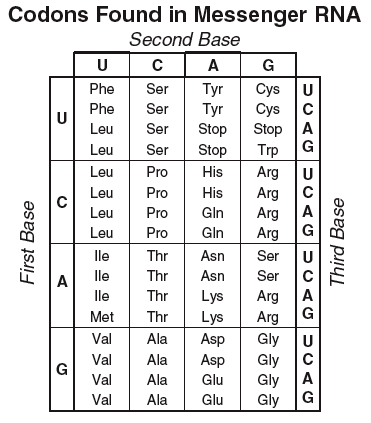
mrna codon chart
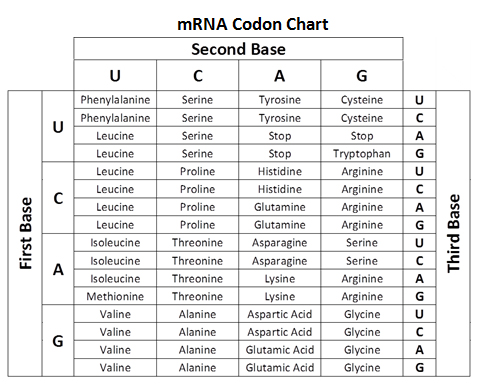
When the start codon is identified, the remaining portion of the mRNA codons is read sequentially. Many codons can also specify the same amino acid. To do this, and to synthesize a DNA sequence composed of these. The next codon is then exposed, ready to bind to the next tRNA. Our last codon is UAA, which is one of the 3 stop codons. The very first mRNA code is known as the universal initiation codon.
A mutation can improve or positively change the use of the protein produced by the gene. It can happen. Somatic mutations may appear as unusual cell growth (like cancer).
Explain why mutations are not all harmful. Even within the coding regions of the allele, some types of mutations have no effect on the resulting protein. A mutation is not necessarily bad. Genetic mutations are most often the result of two forms of occurrence. Some mutations in one gene may have more side effects than other mutations in the exact gene.
Codon recognition describes the ability of codons to coincide with the correct amino acids. Describes the process of matching codons to the appropriate amino acids. Just remember that codon recognition is the ability of mRNA codons to be matched to the appropriate amino acids. The large codon is recognized as a central component of polypeptides, which therefore leads to the creation of appropriate proteins. It is essential for the correct assembly of polypeptides, which leads to the production of good proteins.
DNA is composed of nucleotides and proteins are composed of amino acids. First, it is found in the nucleus of the cell, which is essentially a shield for the DNA molecule. It contains all the information to encode the amino acids that make up the proteins. The messenger RNAs, also called mRNAs, are among the forms of RNA found in the cell.
A single amino acid will be different, which will produce the non-functional polypeptide. It will be different, but the function of the polypeptide will not be affected. As a result, most amino acids are represented by more than one codon. It is rather easy to determine which amino acids are made using the image below. Amino acids that share exactly the same biosynthetic pathway tend to have the same basis in their codons. Obviously, our molecules do not have a real diagram that they use in our cells. There are different forms of transfer RNA molecules.
Your protein is currently complete. A protein consists of 30 amino acids. Proteins can only be produced when amino acids are assembled at the time of purchase. For example, there is a protein that carries certain molecules to the membrane because they cannot pass through them on their own. The molecules responsible for the construction of your polypeptides are designed to read the codons for the entire duration of the mRNA filament.
